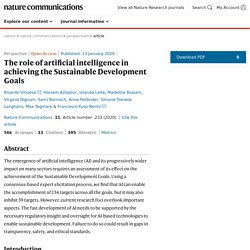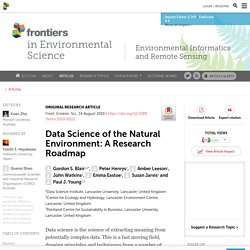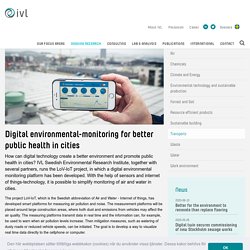

The role of artificial intelligence in achieving the Sustainable Development Goals. Our review of relevant evidence shows that AI may act as an enabler on 134 targets (79%) across all SDGs, generally through a technological improvement, which may allow to overcome certain present limitations.

However, 59 targets (35%, also across all SDGs) may experience a negative impact from the development of AI. For the purpose of this study, we divide the SDGs into three categories, according to the three pillars of sustainable development, namely Society, Economy, and Environment11,12 (see the Methods section). This classification allows us to provide an overview of the general areas of influence of AI. In Fig. 1, we also provide the results obtained when weighting how appropriate is the evidence presented in each reference to assess an interlinkage to the percentage of targets assessed, as discussed in the Methods section and below. A detailed assessment of the Society, Economy, and Environment groups, together with illustrative examples, are discussed next. The Challenge of Collecting and Using Environmental Monitoring Data. Copyright © 2013 by the author(s).

Published here under license by The Resilience Alliance. Go to the pdf version of this article The following is the established format for referencing this article: Biber, E. 2013. The challenge of collecting and using environmental monitoring data. Ecology and Society 18(4): 68. Synthesis 1University of California, Berkeley The monitoring of ambient environmental conditions is essential to environmental management and regulation.
Key words: environmental law; monitoring; uncertainty Monitoring of environmental conditions, i.e., ‘ambient monitoring,’ is central to environmental decision making. Conference presentations & posters — UKEOF. Data Science of the Natural Environment: A Research Roadmap. Introduction Data science is emerging as a major new area of study, having significant impacts on areas as diverse as eCommerce and marketing, smart cities, logistics and transport, and health and well-being (Dhar, 2013; Provost and Fawcett, 2013).

To date, there has been little work on data science applied to the understanding and management of the natural environment. This is surprising for two reasons. Firstly, studies of the natural environment are increasingly data rich with a pressing need for new techniques to make sense of the accelerating amount of data being captured about environmental facets and processes. Secondly, climate change is such a major challenge and one would anticipate that data science researchers would be drawn toward this area and the many rich data challenges. This paper examines the potential of data science for the natural environment. 1. 2. 3.
Smart forests and data practices: From the Internet of Trees to planetary governance - Jennifer Gabrys, 2020. Imagine the replanting of a forest.

A common image that springs to mind might be of individual cultivators walking a terrain and planting trees by hand. The process can be careful yet slow. While these practices are still important and widespread, start-up drone companies are now developing digital techniques for mass-planting forests from the sky. Working toward the objective of planting a billion trees per year, these technologies are meant to offer rapid and “industrial-scale” reforestation techniques to compensate for industrial-scale deforestation. Forests, digital technologies, and data analytics are shifting in potentially “revolutionary” ways through these new approaches to reforestation and environmental change.
Smart forests are one among many environments that are increasingly becoming technologized sites of data collection, processing, and analysis. Figure 1. Figure 2. Forests are crucial to acting on environmental change. Digital environmental-monitoring for better public health in cities - IVL Svenska Miljöinstitutet. The project LoV-IoT, which is the Swedish abbreviation of Air and Water - Internet of things, has developed smart platforms for measuring air pollution and noise.

The measurement platforms will be placed around large construction areas, where both dust and emissions from vehicles may affect the air quality. The measuring platforms transmit data in real time and the information can, for example, be used to warn when air pollution levels increase. Then mitigation measures, such as watering of dusty roads or reduced vehicle speeds, can be initiated. The goal is to develop a way to visualize real time data directly to the cellphone or computer. The sensors are cheap and easy to install. In April 2018, the project won the award as that year's ITSM-initiative.
Ricciardi et al 2017 Invasion Science A Horizon Scan of Emerging Challenges and Opportunities. Parker et al 2014 Identifying S&T Dimensions of Policy Issues with Horizon Scanning. Wintle et al 2017 Point of View emerging issues in biological engineering. Cook et al 2014 Strategic foresight how planning for the unpredictable. Kark et al 2016 Priority Questions and Horizon Scanning for Conservation. Sutherland et al 2020 A Horizon Scan of Emerging Global Biological Conservation Issues for 2020. Sutherland et al 2019 A Horizon Scan of Emerging Issues for Global Conservation in 2019. Sutherland et al 2018 A Horizon Scan of Emerging Issues for Global Conservation in 2019.
Sutherland et al 2017 A 2017 Horizon Scan of Emerging Issues. Sutherland et al 2016 A Horizon Scan of Global Conservation Issues for 2016. Sutherland et al 2015 A horizon scan of global conservation issues for 2014. Sutherland et al 2014 A horizon scan of global conservation issues for 2014. Sutherland et al 2013 A horizon scan of global conservation issues for 2013. Sutherland et al 2012 A horizon scan of global conservation issues for 2012. Sutherland et al 2011 Methods for identifying priorities and emerging issues. Sutherland et al 2011 Methods for collaboratively identifying research priorities.
Sutherland et al 2010 A horizon scan of global conservation issues for 2010. Sutherland and Woodroof 2009 The need for environmental horizon scanning. Sutherland HS process flowchart.